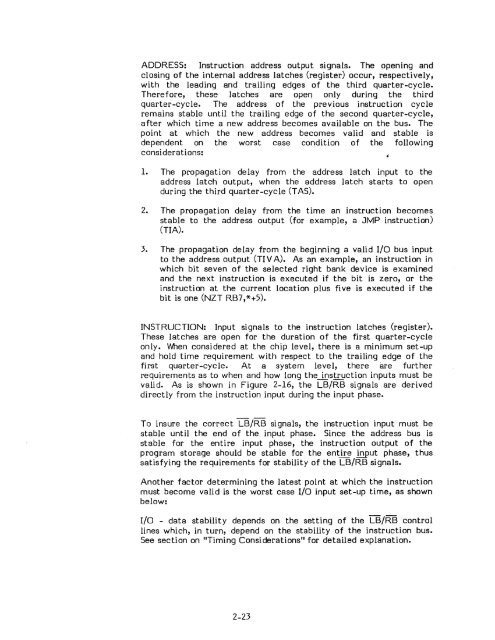8x300 design guide - Al Kossow's Bitsavers - Trailing-Edge
8x300 design guide - Al Kossow's Bitsavers - Trailing-Edge
8x300 design guide - Al Kossow's Bitsavers - Trailing-Edge
Create successful ePaper yourself
Turn your PDF publications into a flip-book with our unique Google optimized e-Paper software.
ADDRESS: Instruction address output signals. The opening and<br />
closing of the internal address latches (register) occur, respectively,<br />
with the leading and trailing edges of the third quarter-cycle.<br />
Therefore, these latches are open only during the third<br />
quarter-cycle. The address of the previous instruction cycle<br />
remains stable until the trailing edge of the second quarter-cycle,<br />
after which time a new address becomes available on the bus. The<br />
point at which the new address becomes valid and stable is<br />
dependent on the worst case condition of the following<br />
considerations:<br />
1. The propagation delay from the address latch input to the<br />
address latch output, when the address latch starts to open<br />
during the third quarter-cycle (T AS).<br />
2. The propagation delay from the time an instruction becomes<br />
stable to the address output (for example, a JMP instruction)<br />
(TIA).<br />
3. The propagation delay from the beginning a valid I/o bus input<br />
to the address output (TI V A). As an example, an instruction in<br />
which bit seven of the selected right bank device is examined<br />
and the next instruction is executed if the bit is zero, or the<br />
instruction at the current location plus fi ve is executed if the<br />
bit is one (NZT RB7, *+5).<br />
INSTRUCTION: Input signals to the instruction latches (register).<br />
These latches are open for the duration of the first quarter-cycle<br />
only. When considered at the chip level, there is a minimum set-up<br />
and hold time requirement with respect to the trailing edge of the<br />
first quarter-cycle. At a system level, there are further<br />
requirements as to when and how long the-.illstruction inputs must be<br />
valid. As is shown in Figure 2-16, the LB/RB signals are derived<br />
directly from the instruction input during the input phase.<br />
To insure the correct LB/RB signals, the instruction input must be<br />
stable until the end of the input phase. Since the address bus is<br />
stable for the entire input phase, the instruction output of the<br />
program storage should be stable for the entire lill>ut phase, thus<br />
satisfying the requirements for stability of the LB/RB signals.<br />
Another factor determining the latest point at which the instruction<br />
must become vali d is the worst case I/O input set-up time, as shown<br />
below:<br />
I/O - data stability depends on the setting of the LB/RB control<br />
lines which, in turn, depend on the stability of the instruction bus.<br />
See section on "Timing Considerations" for detailed explanation.<br />
2-23

















